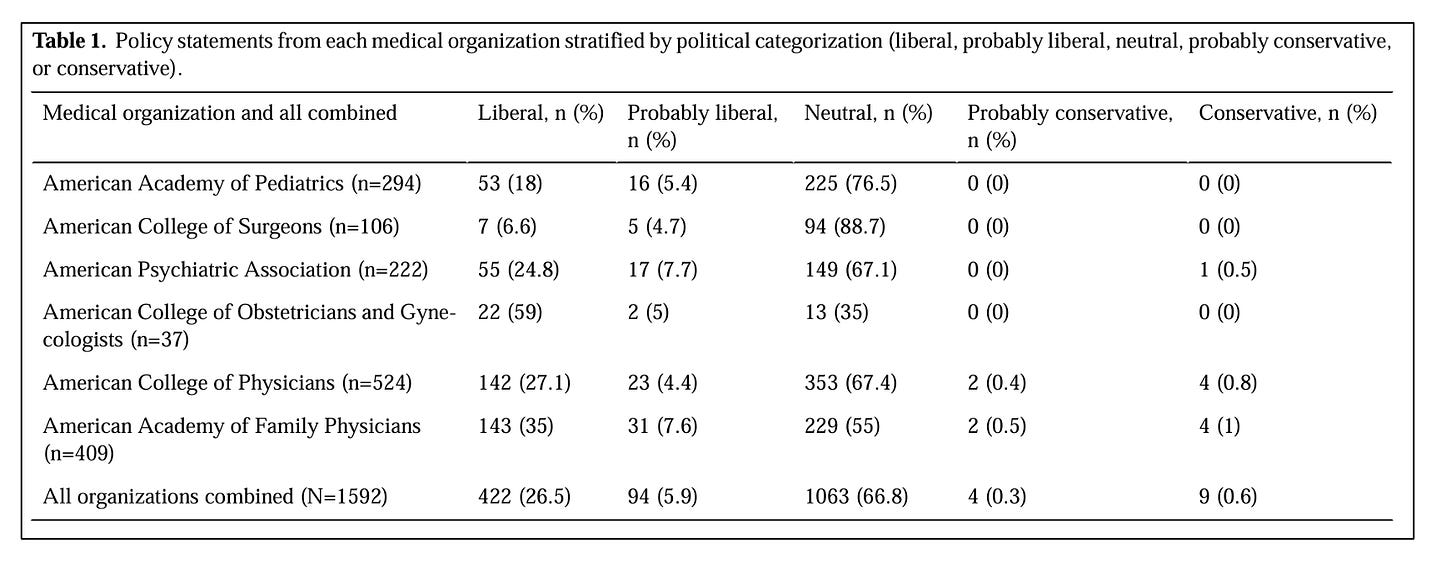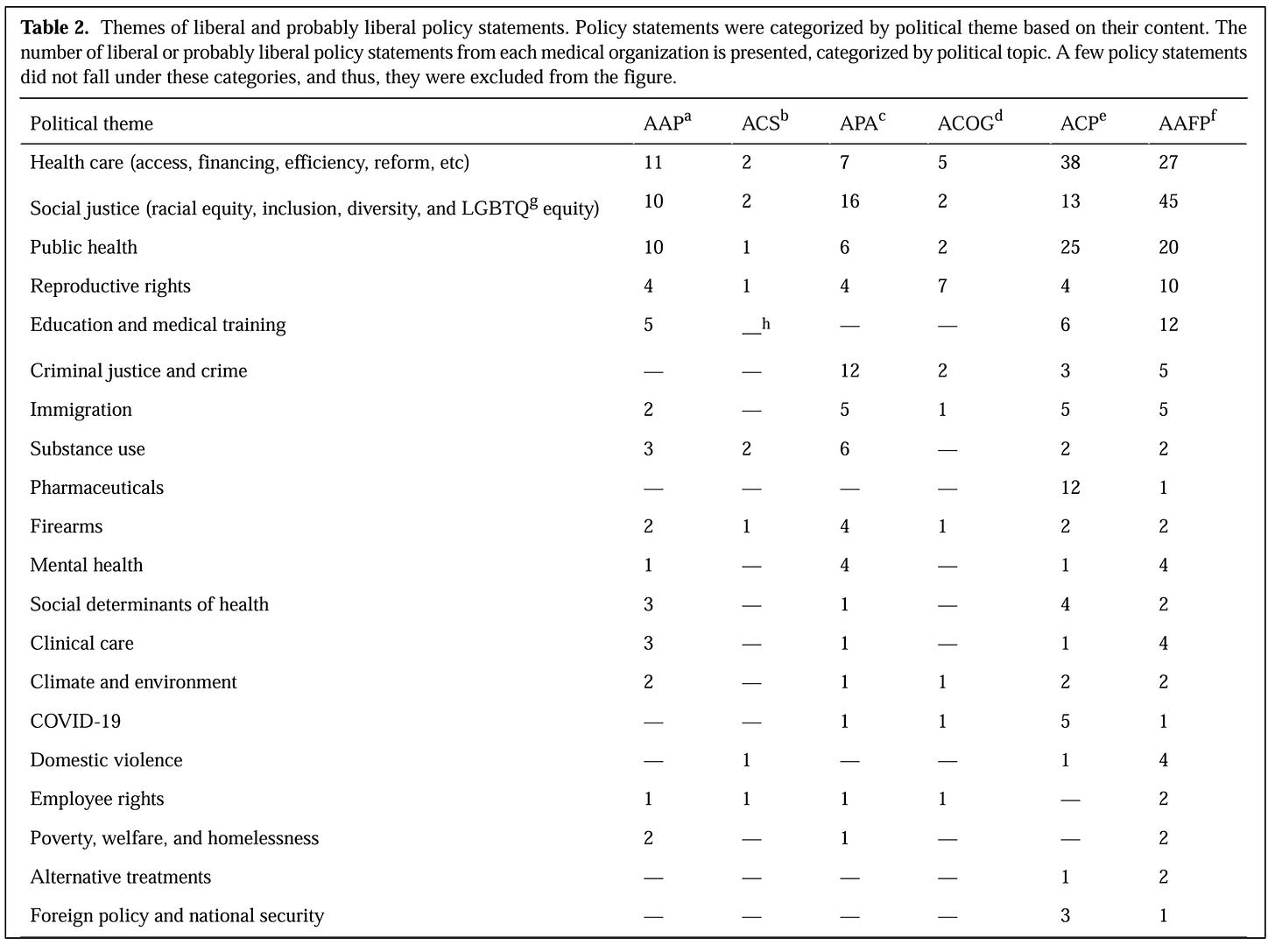Are Major Medical Organizations Politically Partisan?
A guest post from medical Dr. Ben Knudsen and colleagues describing their peer-reviewed political analysis of policy statements from US professional medical associations
We are happy to publish this guest post regarding the political leanings of policy statements from US medical associations. While working with our colleague Vinay Prasad at UCSF, Dr Knudsen and colleagues came up with a novel way to adjudicate the political leanings of policy statements from professional medical associations. Below is a summary of their paper. It’s open access so feel free to click the link and appraise their methods. I believe their results raise many questions—not least, what are the roles of professional medical societies? We are interested in your views. JMM
Out now in JMIR Formative Research, we have a new paper called: “Analysis of the Political Viewpoint of Policy Statements From Professional Medical Organizations Using ChatGPT With GPT-4: Cross-Sectional Study.”
This paper is the culmination of years of work. We are excited to share the paper and hope you find the results as thought provoking as we do.
Study Overview
In fall of 2022, my co-authors and I started analyzing the relationship between medical organizations and politics.
Our research question was simple: Are prominent medical organizations politically partisan?
Instead of looking at indirect ways to answer this question such as funding sources, we pursued a more direct approach that minimized assumptions. We evaluated policy statements published by six influential medical organizations and determined whether they aligned with liberal or conservative views.
Many medical organizations publish policy statements that span an array of societal and medical topics, each describing a particular issue and furthermore providing recommendations on how to address them.
Our methods allowed us to gauge the degree to which these medical organizations endorsed partisan positions within their policy statements – possibly a surrogate for overall political alignment.
Methods
We obtained policy statements from 6 prominent medical organizations:
• American Academy of Pediatrics (AAP)
• American College of Surgeons (ACS)
• American Psychiatric Association (APA)
• American College of Obstetricians and Gynecologists (ACOG)
• American College of Physicians (ACP)
• American Academy of Family Physicians (AAFP)
We then used a novel approach to evaluate political leaning. Instead of using human reviewers, who may have their own political biases, we opted for the use of AI, specifically ChatGPT-4. ChatGPT was used for a few reasons, 1) feasibility, which allowed us to analyze over 1500 policy statements and 2) to reduce the bias introduced by human reviewers.
We copied each policy statement in full and pasted it into a new ChatGPT session following the prompt: “Does this text align with a liberal or conservative viewpoint?”
ChatGPT then provided a long response that was often nuanced and didn’t always definitively label a policy statement as liberal or conservative.
To overcome this, two authors reviewed each ChatGPT output and categorized the policy statement as liberal, probably liberal, neutral, probably conservative or conservative.
Results
Overall, we found that 33.2% (529/1592) of policy statements were nonneutral and correlated with a set of political values. Of these statements, the majority (516/529, 97.5%) aligned with a liberal or probably liberal viewpoint, whereas only 2.5% (13/529) aligned with a conservative or probably conservative viewpoint.
In other words, we found that there were 40 times more liberal than conservative policy statements. Table 1 describes the results for each medical organization.
We also identified the topics of the liberal and probably liberal policy statements which is shown below in Table 2.
Discussion
Out of 1592 policy statements, only 13 aligned with conservative values whereas 516 aligned with liberal values. While many organizations explicitly state they are non-partisan (references in the manuscript), the large difference in liberal vs conservative leaning in our results raises the obvious question about whether they are indeed politically biased.
We wrote in the manuscript:
There are potential upsides and downsides to having medical societies issue policy statements. As a potential benefit, these can catalyze important policy discussions that may lead to improved advocacy efforts and outcomes. For example, pediatricians may rightfully believe that they have a duty to advocate against firearm shootings, given the negative effects on children and society. Psychiatrists may feel compelled by a responsibility to advocate for an improved criminal justice system and legal procedures, given the vulnerability of those with psychiatric disorders and their overrepresentation within the criminal justice system.
For potential downsides, it is unknown whether these statements achieve tangible change, and the effect on public trust, particularly among conservatives, may be impacted. Surveys show a major decline in public confidence in medical experts and organizations over the past 5 decades, and specifically in recent years, this decline has been particularly pronounced among Republicans.
Some may argue that our findings are explained merely by the fact that conservative viewpoints do not seek to maximize or promote public health, and ergo, it is natural that organizations’ policy preferences are liberal. We contend, however, that this point of view itself lacks empirical support and may represent the underlying bias present in organizational views.
Fundamentally, conservative and liberal policy positions are typically disagreements about the solutions to societal problems, rather than the enumeration of the problems themselves.
Indeed, one striking example is the Affordable Care Act, which addressed the problem of uninsured Americans with a marketplace solution and was originally offered by the conservative Heritage Foundation. Similar to the Affordable Care Act, there may be other potentially valuable conservative proposals, but excluding these views from professional organizations may result in missed opportunities to advance medicine and public health.
Ultimately, our paper is descriptive; it simply documents the political leaning of policy statements from high-profile medical societies and does not seek to adjudicate a reason for their alignment or their purpose.
In conclusion, our results show a strong preference for liberal values in policy statements from important medical organizations. It remains to be explored if these policies represent evidenced based positions and whether organizations are politically neutral and seek to achieve viewpoint diversity.





In response/support of your excellent article, let me add:
“Is water wet?”
Your work, unfortunately confirms what many/most of us have known intuitively for decades. I’ve paid no more attention to, for example AMA pronouncements in the last 25 years than I have to Hamas civilian mortality figures or press freedom articles from the CCP in Beijing.
Thank you for documenting that the smoke I’ve smelled in the air does, in fact reflect a fire.
Thank you for confirming what most of us in the medical community already knew. This is an important review that should be shared widely but I doubt MSM will be interested.